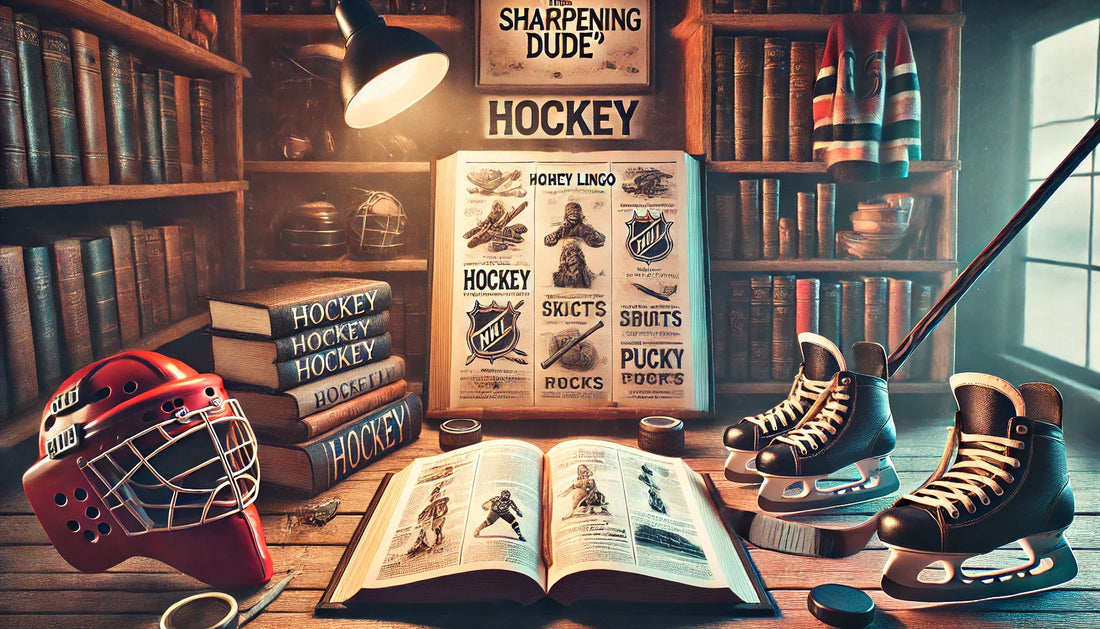
The Sharpening Dude's Hockey 101 | Hockey Lingo
Share
Speak Like a Pro, Not a Pigeon
Basic Terms & Lingo
“A”: Letter worn on the uniform of the assistant team captain.
ADM: The American Development Model is the primary model for youth hockey in the US. The ADM is designed to successfully develop hockey players by implementing long-term athlete development principles.
Assist: An assist is credited to a player who helps set up a goal. Assists are awarded to the last two offensive players to handle the puck prior to a goal, including those who shoot the puck on net.
Breakaway: A clear scoring opportunity where no defensive player is between the puck carrier and the goaltender.
“C”: Letter worn on the uniform of the team captain.
Crease: Blue semi-circle in front of the goal. Goaltenders receive special privileges and protection while in this area.
Deke: A fake by a player in possession of the puck in order to get around an opponent or to make a goalie move out of position.
Diving: When a player exaggerates being hooked or tripped in an attempt to draw a penalty.
Empty Netter: A goal scored against an opponent that has pulled the goalie for an extra attacker in an attempt to tie the game. This typically happens late in the third period with under two minutes to play in the game.
Forecheck: The way a team's forwards put pressure on the opposing team while in the offensive zone in an effort to keep the puck or take it away from the opposition.
Freezing the Puck: A goalie freezes the puck (when the opposition is threatening to score) by either holding the puck in the glove or trapping it on the ice.
Full Strength: When a team has five skaters on the ice plus their goaltender.
Hat Trick: A player who scores three goals in one game achieves a "hat trick."
"HEP": This acronym refers to Minnesota Hockey's Hockey Education Program. HEP actively encourages a positive athletic experience for youth hockey players by providing a comprehensive approach to player development through parent education and accountability.
Intermission: A break in between each of the three periods.
"LTAD": Stands for long-term athlete development. LTAD provides a holistic model of development for all athletes through a gradual progression of skills and training programs.
One-timer: Shooting the puck immediately upon receiving it without stopping it first.
Penalty Kill: When a team is shorthanded (only four players on the ice) due to a penalty and attempts to prevent the opposition from scoring.
Penalty Shot: A free shot, unopposed except for the goalie, most commonly award to players that have full possession with no opposing player between them and the goalie but are taken down by the opposition. The team which commits the offense is not penalized beyond the penalty shot, whether it succeeds or not.
Power Play: Happens when a team has a one- or two-man advantage over the opposition due to penalties.
Rink: The ice on which the game of hockey is played. Rinks are typically 200-feet long by 85-feet wide. This is also referred to as an NHL-sized rink. Olympic rinks are 200-feet long by 100-feet wide.
Save: When a goalie prevents a shot from going into the net.
Screen: Occurs when one or more players are between the shooter and the goalie, shielding the goalie’s view of the play and incoming shot.
Shot on Goal: An attempt by the attacking team to score a goal by shooting the puck toward the net. This results in either a save or a goal.
Shorthanded: Happens to your team when the opposing team has a one- or two-man advantage due to penalties.
Slap Shot: A slap shot occurs when the player swings the stick back and then quickly forward, slapping the puck ahead with a forehand shot.
Snap Shot: An abbreviated slap shot that occurs without the stick leaving the ice. The purpose of the snap shot is to combine the main advantages of the wrist shot (shot accuracy and quick delivery) and the slap shot (puck speed).
Stick-handling: A term for carrying the puck along the ice with the stick.
Turnover: Losing control of the puck to the opposing team.
Wrist Shot: Players roll their wrists quickly and powerfully to generate a shot. Typically, the most common and accurate type of shot.
Zamboni: The vehicle used to prepare the rink's ice surface before the game and during intermissions. The Zamboni scrapes a thin layer off the ice while also puting down a fresh layer of heated water that freezes to form a new layer of ice.
Advanced Hockey Lingo:
Backchecking: Forwards in the attacking zone skate back to their own end to prevent opponent’s shots on goal.
Biscuit: A common term for a hockey puck.
Barn: A common term for an ice rink.
Barn Burner: A very intense game where the crowd becomes loud and boisterous.
Box: A defensive system (similar to the diamond) often used by teams on the penalty kill.
Breakout: The play used by the attacking team to move the puck out of its own zone and up the ice toward the opponent's goal.
Butterfly: A style of goaltending where the goalie tends to cover the lower half of the net with his or her leg pads.
Bucket: Slang term for a helmet.
Cherry Picking: When a player, generally a forward, hangs out by the red line while the play is in his/her team's defensive zone. The player is waiting for an outlet pass so that he can have a breakaway.
Changing on the Fly: When players from the bench substitute for players on the ice while the clock is running.
Coast to Coast: Refers to when a player carries the puck from deep in his own defensive zone, all the way to the opposing team’s goal.
Crashing the Net: A strategy in which a forward heads toward the opponent's net in hopes of deflecting a shot, banging a loose puck in, obstructing the goaltender's view, or simply creating mayhem that could lead to a scoring chance for his team.
Dangling: When a player uses great stickhandling moves to skate through the opposing team while maintaining possession of the puck.
Dump and Chase: A style of hockey where a team shoots the puck into one of the corners of the offensive zone and then pursues it.
Five-Hole: The hole between the goalie’s leg pads. If a player scores a goal and the puck went in between the goalie’s pads, the puck went through the five-hole.
Garbage Goal: A goal that takes little talent to score. Most such goals are scored from right in front of the net, often when the goaltender is out of position.
Headmanning: When a player passes the puck to a teammate who is ahead and typically closer to the opposing team's goal.
Howitzer: A very fast slap shot.
Laser: A hard, accurate shot.
Light the Lamp: To “light the lamp” is to score a goal. There is a goal judge positioned right behind the net who activates a red light when the puck crosses the goal line.
Natural Hat Trick: Scoring three goals in a row.
Neutral Zone Trap: A defensive ice-hockey strategy used by a team to prevent an opposing team from proceeding through the neutral zone (the area between both blue lines) by forcing turnovers in that area.
Odd-Man Rush: When one team races towards the opposing teams goalie with an extra player. Usually either a two-on-one or three-on-two into the offensive zone.
Pinch: Defensemen are usually positioned near the blue line in the offensive zone, but a "pinching" defenseman will leave his position and push further into the offensive zone in order to support the forwards and keep the puck in the zone.
Pipe: The pipe is the goal post. Also referred to as the "iron".
Point: A position just inside the blue line usually occupied by a defenseman when their team is in control of the puck in the offensive zone.
Poke Check: Trying to knock the puck away from an opponent by stabbing at it with the blade of the stick.
Pulling the Goalie: A team that is losing will sometimes take their own goalie off the ice and use another forward. This situation occurs most frequently near the end of the game when a team is behind and needs some emergency offense.
“The Room”: A hockey team's dressing room. It also loosely refers to a team's chemistry or aura that surrounds the team, or a team's camaraderie.
Saucer pass: An airborne pass from one player to another. It is called a saucer pass because the puck resembles a flying saucer in midair.
Shadow: When a player covers an opponent one-on-one everywhere on the ice in order to limit the effectiveness of his opponent.
Shinny: A pick-up game of hockey usually played on a frozen pond.
Shorty: A shorthanded goal.
Sieve: Slang term for a goalie that gives up a lot of goals and appears to have a lot of holes.
Sin Bin: Place a player goes after he is called for a penalty. Also simply known as the penalty box.
Slot: The prime scoring area up the middle of the ice, between the face-off circles in the attack zone.
Sniper: A player who is a pure goal scorer who is always able to find open space to get his shot off.
Stack the Pads: A save where the goaltender drops to one side and makes the save with her leg pads stacked on top of one another.
Standing on his Head: Phrase used when a goaltender is making outstanding saves. Often used when a goalie is carrying her team and giving them a chance to win a game they shouldn't win.
Sweater: Another word for a hockey jersey. Refers to the old school hockey jerseys that were thick and heavy, making them similar to a sweater.
Tic-Tac-Toe: Three tape-to-tape passes that lead to a goal. Tic-tac-toe goals are usually scored on odd-man rushes or power plays because opponents don't have enough defenders to break up passes.
Toe Drag: Dragging the puck along the ice with the end (toe) of the stick blade on the ice as opposed to the bottom edge.
Top Shelf: Placing a shot in the top quarter of the net.
Traffic: A lot of players gathered in one area, usually in front of the net.
Wholesale Change: When every player on a team goes to the bench for a line change at the same time.
Wraparound: A player skates behind the opposing goal and attempts to wrap the puck around the goal post and into the net.
